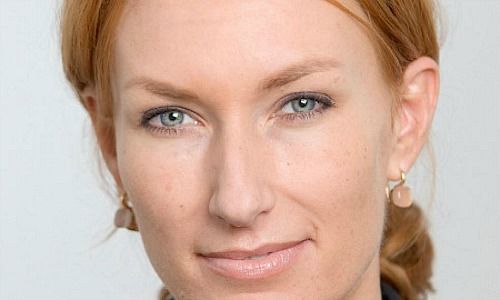The Ex-UBS Banker Whipping Credit Suisse's Swiss Unit into Shape
The former CFO of UBS in Singapore has taken on a new challenge at arch rival Credit Suisse in Switzerland.The bank has entrusted its Swiss unit to one of Switzerland’s few high-ranking female bankers.
In the 1970s, influential politician, anti-trust expert, law professor and Swiss central banker Leo Schuermann eschewed the chauffeured sedan available to him as a high-ranking government official, opting to take his bicycle or public transport instead.
His granddaughter, Dagmar Kamber Borens would probably have – like most children – jumped at the chance to ride in a chauffeured sedan, but Schuermann's stance was a quintessentially Swiss one: stay grounded and modest, no matter where your career takes you.
It is a message that will serve the 44-year-old well going into a career-defining year: she is Credit Suisse’s point person to whip its domestic unit into shape ahead of a planned minority listing expected to reap billions.
Cryan's «Rottweiler»
Responsible for 4,000 employees, Kamber Boren's job includes all operational aspects and setting the newly-created bank’s three- to five-year strategy, including specifics on digitization’s disruptive role on the bank’s offerings.
Who is she? After earning her PhD in law, her rise through UBS’ ranks was meteoric and fueled by fealty to high-profile and demanding mentors. She made Managing Director one month before the bank was forced to take a $60 billion government bailout in 2008. That same month, she moved from the powerful, highly controversial and since-scrapped chairman’s office to that of John Cryan, then the bank’s financial chief who helped orchestrate the bailout.
She spent four years working for Cryan, who is now helming Deutsche Bank’s turnaround, and later Tom Naratil, as Chief of Staff. Cryan, according to several people familiar with the matter, approvingly referred to her as his «Rottweiler» for her ruthless discipline in clearing the decks for him.
Singapore Assignment
Like most guard-dogs, Kamber Borens is eminently capable, tough and ambitious, but has also proved a savvy operator within a highly political organization such as UBS, and isn't afraid to use her ample emotional intelligence and charm, those who have worked with her in the past report. Her experience is broad: she has worked in strategy, mergers-and-acquisitions, private banking, and finance.
Four years ago, UBS transferred her to Singapore, where she became finance chief of the wider region – her first step into the spotlight as well as her first foreign assignment. As a mother of three and one half of an ascending power couple, the tantalizing opportunity required deft organizational skill by Kamber Borens and her partner, Swiss securities lawyer Philippe Borens.
She stayed in Singapore for four years, drawing together UBS functions, responsibilities and reporting lines that had until then been fragmented. UBS had offered Kamber Borens another plum finance job within UBS, which she turned down: after eight years in finance, she didn't want to be pigeon-holed to a CFO role, according to a person familiar with the matter.
«Equity Story»
Her surprise hire as Credit Suisse’s operating chief for its Swiss unit – one of a host of hires from UBS – is the next logical step for an ambitious banker on the move. In her new role, she must pull off the pressure-filled high-wire act before her, as well as navigate a clash of cultures. While Credit Suisse is well-known for fostering entrepreneurial thinkers, UBS has typically followed a more deliberate and disciplined military-style approach: define a strategy and stick to it, come hell or high water.
What are the next steps? The bank’s Swiss unit has been carved out, but hammering out a strategy as a semi-independent entity awaits. Initial measures include consolidating holdings such as retail bank Neue Aargauer Bank (NAB), credit card provider Swisscard, and consumer lender Bank-now, sorting out what part of the bank’s arcane and messy information technology platform will remain at the Swiss unit following the public listing, and creating what investment bankers call an «equity story».
In other words, shopping the bank to potential IPO investors in order to raise as much desperately-needed capital as possible for the parent bank.
Broken With Veterans
She has wasted little time enlisting the help of promising talent within the bank for her push, and broken with respected veterans such as Marco Abele, who she passed over as the Swiss unit’s digital head in favor on a virtually unknown 37-year-old female banker.
The reality is that Kamber Borens doesn't have time to wait out a six-month gardening leave if she wanted to poach a former colleague from UBS – she needs people in seats immediately to stand up the equity story in coming months.
And what is that story? The Swiss unit is the bank’s most consistently functioning, profitable and cost-disciplined jewel – Credit Suisse, but better. The very definition of Swissness, it has a far stronger corporate and investment banking franchise than UBS in Switzerland, which the bank argues is the perfect setup for the «entrepreneur’s bank» that Swiss unit CEO Thomas Gottstein seeks to become.
In UBS' Crisis Engine Room
To be sure, the Swiss unit faces the same stiff headwinds as all its competitors: the wealthy remain hugely reluctant to invest, preferring to stash cash and cash products – which earn nothing for the bank – negative interest rates are eating into margins, heightened competition and more regulation pose threats, and cost-cutting is a constant companion.
What’s at stake? Kamber Borens can surely stand the heat, having been in the engine room when UBS tapped shareholders for billions to stem its mortgage losses and then helping Cryan mop up the aftermath of the bailout. Credit Suisse, which survived the financial crisis without a government bailout, arguably has nearly as much at stake in 2017. Kamber Borens – now out of the engine room and on the front lines – has more at stake.
Why? Tidjane Tham desperately needs the capital from a successful public listing, should markets in the latter half of next year cooperate and allow one. The bank expects the move to sweep 1 to 2 billion into its capital coffers, a key measure of its return to health. Much of the success of this move rests on Kamber Borens’ shoulders.



























